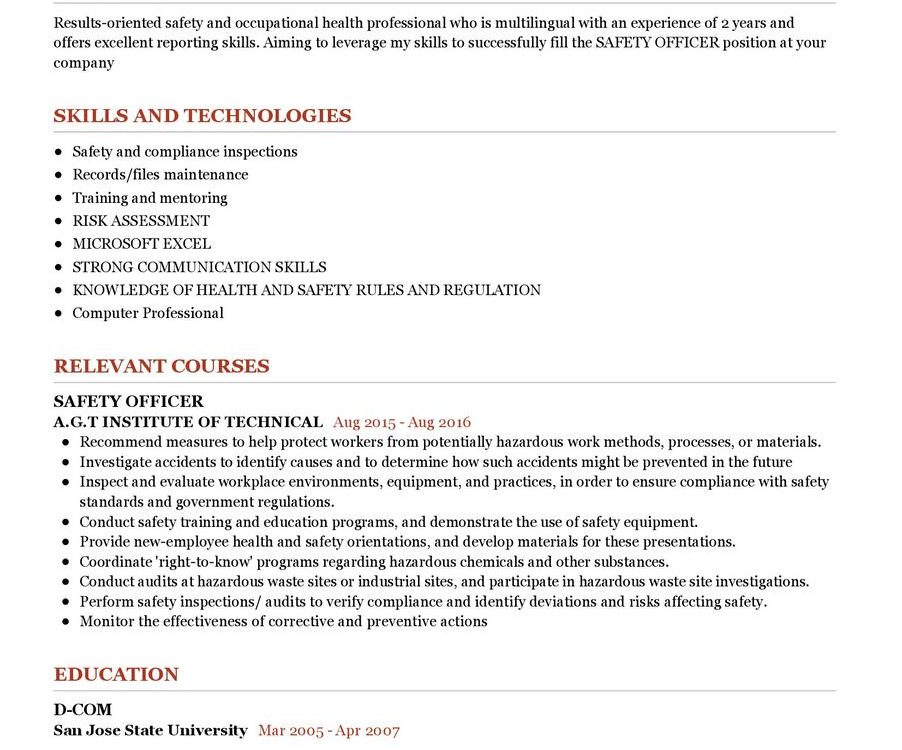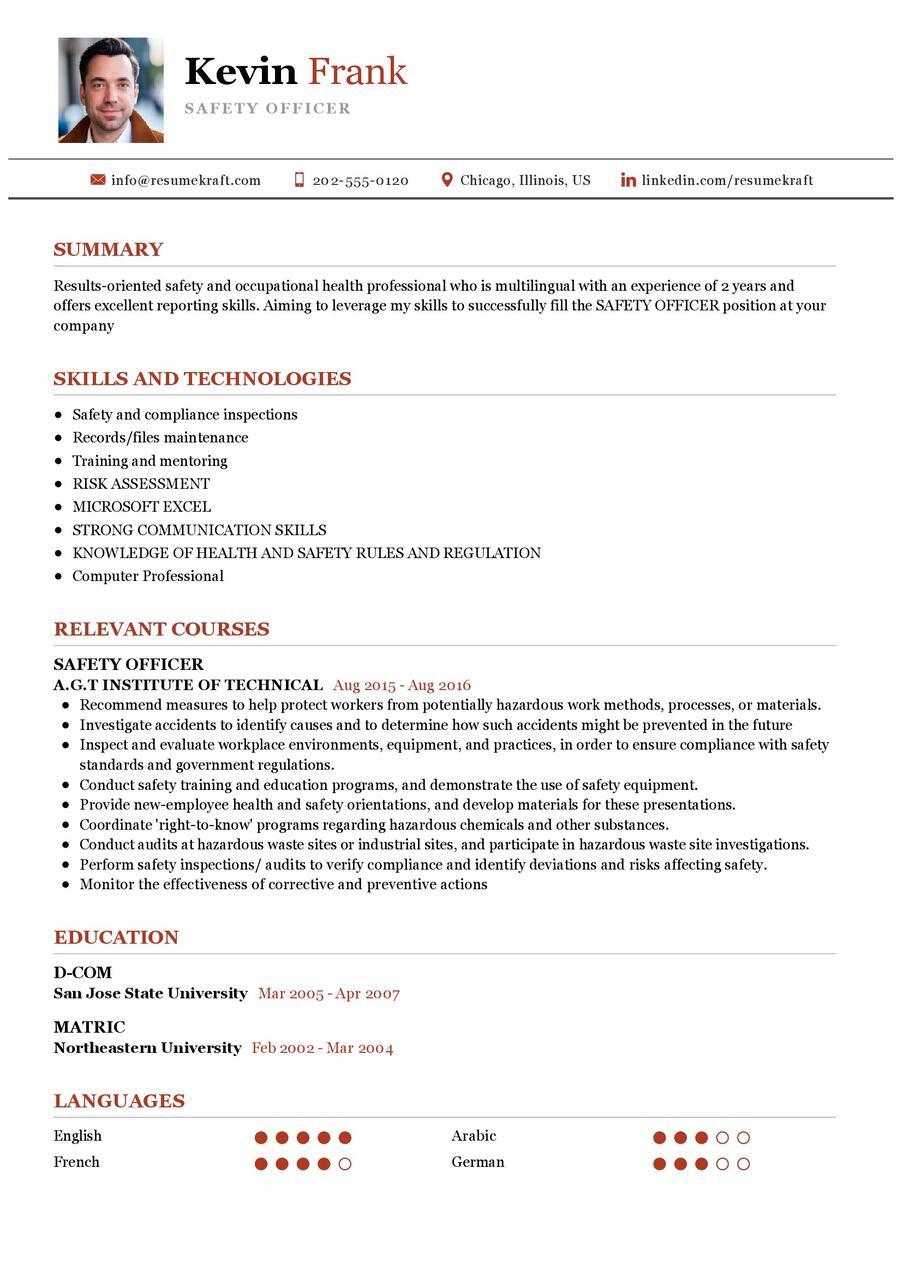The Role of a Safety Officer: Ensuring Workplace Well-being
As workplaces prioritize employee safety and well-being, the role of a Safety Officer has become paramount. This position blends technical expertise with a commitment to creating a secure work environment. Let’s delve into the multifaceted responsibilities of a Safety Officer, a role crucial for fostering a culture of safety in organizations.
What are the Safety Officer Job Requirements?
Becoming a Safety Officer involves meeting specific requirements, a journey that demands continuous learning and hands-on experience. To step into this role, one should:
- Hold a Bachelor’s or Master’s degree in Occupational Health and Safety or a related field, showcasing a solid foundation in safety practices.
- Demonstrate comprehensive knowledge of safety regulations, risk assessment, and emergency response protocols.
- Have practical experience in conducting safety inspections, audits, and creating effective safety programs.
- Possess excellent communication and training skills to educate employees on safety procedures.
- Show proficiency in using safety management systems and related software.
- Exhibit strong attention to detail and the ability to analyze data for identifying potential safety hazards.
Acquiring additional certifications in occupational health and safety can enhance your profile and stand out in the competitive job market.
Responsibilities of a Safety Officer
The role of a Safety Officer is dynamic, encompassing various responsibilities that contribute to a safe and secure work environment. Some key responsibilities include:
- Conducting regular safety inspections and risk assessments to identify and mitigate potential hazards.
- Developing and implementing safety policies, procedures, and training programs to ensure compliance with regulations.
- Collaborating with management to create emergency response plans and conducting drills to ensure preparedness.
- Investigating workplace incidents, analyzing root causes, and recommending corrective actions.
- Providing safety training to employees, emphasizing the importance of adherence to safety protocols.
- Maintaining up-to-date knowledge of safety regulations and ensuring the organization’s compliance.
- Leading safety committees and actively engaging with employees to promote a culture of safety.
Each responsibility requires a combination of technical expertise and effective communication to ensure a safe and secure work environment.
Safety Officer CV Writing Tips
Crafting a compelling Safety Officer CV is essential to stand out in the job application process. Consider the following tips:
- Highlight specific safety programs you have implemented and their impact on reducing workplace incidents.
- Detail your experience in conducting thorough safety inspections and your role in creating a safer work environment.
- Quantify achievements by including statistics on incident reduction or successful implementation of safety initiatives.
- List relevant certifications, showcasing your commitment to ongoing professional development in occupational health and safety.
- Customize your CV for each application, aligning your skills and experience with the specific job requirements.
Your CV is a reflection of your commitment to workplace safety and your ability to contribute to a secure working environment.
Safety Officer CV Summary Examples
Your CV summary serves as an introduction to your professional journey. Craft a powerful summary that encapsulates your experience and expertise:
- “Dedicated Safety Officer with over 8 years of experience, implementing robust safety programs that resulted in a 30% reduction in workplace incidents.”
- “Experienced Safety Officer adept at conducting thorough risk assessments and creating targeted training programs, contributing to a culture of safety and compliance.”
- “Results-driven Safety Officer with a track record of developing and implementing emergency response plans, ensuring organizational readiness in crisis situations.”
Your CV summary is a snapshot of your commitment to safety and your ability to make a meaningful impact in the workplace.
Create a Strong Experience Section for Your Safety Officer CV
Your experience section is the core of your CV, detailing your achievements and contributions in the field of occupational health and safety. Consider the following examples:
- “Led safety initiatives resulting in a 25% decrease in workplace accidents over a two-year period.”
- “Implemented a comprehensive safety training program, leading to a 50% increase in employee awareness and compliance.”
- “Conducted regular safety audits, identifying and rectifying potential hazards, ensuring a safe work environment for all employees.”
Each experience showcases your hands-on involvement in creating and maintaining a safe workplace.
Safety Officer Education Section for Your CV
Your educational background is a testament to your expertise in occupational health and safety. Structure your education section as follows:
- Master of Science in Occupational Health and Safety, XYZ University, equipped with in-depth knowledge of safety management, 2017.
- Bachelor of Science in Environmental Health and Safety, ABC University, the foundation of your understanding of workplace safety, 2014.
- Certified Safety Professional (CSP), demonstrating your commitment to professional development, 2019.
Your education is the backbone of your ability to navigate and implement safety protocols in the workplace.
Safety Officer Skills for Your CV
Your skill set is a toolkit showcasing your ability to ensure workplace safety. Include the following essential skills in your CV:
Soft Skills:
- Communication and training skills, essential for conveying safety information effectively to employees.
- Attention to detail, crucial for identifying and addressing potential safety hazards.
- Leadership and teamwork, necessary for fostering a culture of safety among employees.
- Problem-solving abilities, vital for analyzing incidents and recommending corrective actions.
- Adaptability, the capacity to respond to changing safety regulations and workplace conditions.
Hard Skills:
- Proficiency in safety management systems, showcasing your ability to use technology for enhancing workplace safety.
- Knowledge of occupational health and safety regulations, ensuring compliance and adherence to standards.
- Emergency response planning, a skill critical for preparing organizations for unforeseen events.
- Risk assessment and analysis, essential for identifying and mitigating potential safety threats.
- Data analysis, for evaluating safety metrics and continuously improving safety programs.
Each skill in your toolkit contributes to creating a safer and more secure work environment.
Common Mistakes to Avoid When Writing a Safety Officer CV
Steer clear of common pitfalls when crafting your CV to ensure it effectively communicates your qualifications and experience:
- Avoid using generic statements; instead, tailor your CV to highlight your specific contributions to workplace safety.
- Focus on achievements rather than responsibilities to provide a more comprehensive view of your impact.
- Include a well-crafted cover letter to complement your CV, providing additional context and showcasing your enthusiasm for the role.
- Translate technical jargon into easily understandable language to ensure clarity for a diverse audience.
- Thoroughly proofread your CV to present a polished and professional image to potential employers.
Each mistake avoided contributes to a CV that effectively communicates your expertise and commitment to workplace safety.
Key Takeaways for Your Safety Officer CV
As you conclude your CV crafting journey, remember these key points to make your Safety Officer CV stand out:
- Highlight your specific contributions to reducing workplace incidents and creating a safer work environment.
- Showcase your technical proficiency in safety management systems and adherence to regulations.
- Detail the strategic initiatives you’ve led, emphasizing your visionary approach to workplace safety.
- Include a section on continuous learning, showcasing relevant certifications and courses undertaken to stay updated on safety practices.
Finally, feel free to utilize resources like AI CV Builder, CV Design, CV Samples, CV Examples, CV Skills, CV Help, CV Synonyms, and Job Responsibilities to create a standout application and prepare for the Safety Officer job interview.
Armed with these insights and tips, you are now ready to craft a CV that is a true reflection of your commitment to workplace safety, your skills, and your aspirations. Best of luck!


